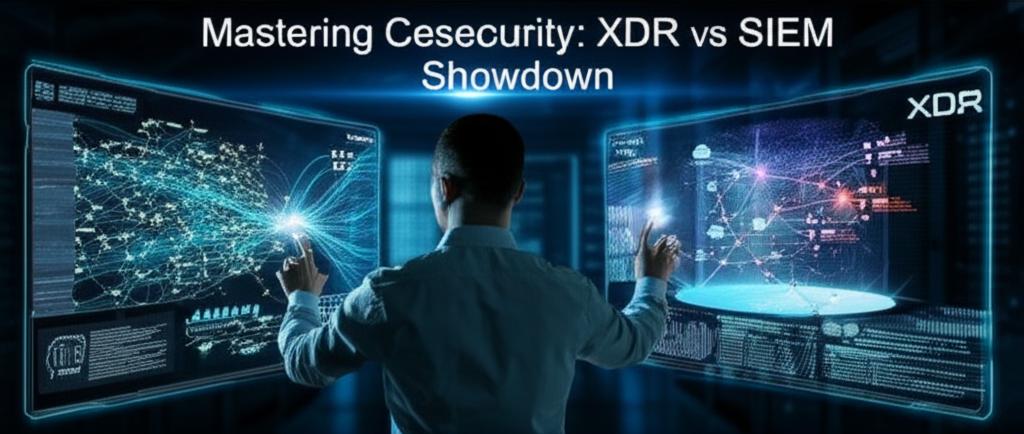Mastering Cybersecurity: The Crucial XDR vs SIEM Showdown
Decoding Cybersecurity: XDR vs SIEM – A Comprehensive Guide
In the evolving landscape of digital threats, organizations face the formidable challenge of protecting their assets from sophisticated cyberattacks. Two prominent technologies, Extended Detection and Response (XDR) and Security Information and Event Management (SIEM), stand out as critical tools in the cybersecurity arsenal. While both aim to enhance security posture, they approach threat detection and response from distinct angles. Understanding the fundamental differences and potential synergies in the XDR vs SIEM debate is essential for crafting an effective security strategy.
What is SIEM? The Foundation of Log Management and Compliance
Security Information and Event Management (SIEM) platforms have been a cornerstone of enterprise security for decades. A SIEM solution primarily focuses on collecting and aggregating log data and event information from a wide array of sources across an organization’s IT infrastructure. This includes network devices, servers, applications, security tools (like firewalls and antivirus), and more. Once collected, the data is normalized, correlated, and analyzed to identify potential security incidents, compliance breaches, and operational issues.
- Key Capabilities:
- Centralized log collection and storage
- Real-time event correlation and alerting
- Compliance reporting (e.g., GDPR, HIPAA, PCI DSS)
- Threat detection based on known signatures and rule-sets
- Security analytics and forensic capabilities
- Strengths: Excellent for compliance, long-term data retention, and providing a broad, centralized view of security events across the entire IT estate.
- Challenges: Can generate a high volume of alerts (alert fatigue), often requires significant tuning and expertise, and may struggle with advanced, unknown threats without extensive custom rules.
What is XDR? The Evolution of Detection and Response
Extended Detection and Response (XDR) represents a newer, more integrated approach to threat detection and incident response. Unlike SIEM, which cast a wide net for all logs, XDR focuses on deeply integrating security data from specific domains, such as endpoints, networks, cloud environments, and email. By consolidating and correlating data across these predefined security layers, XDR aims to provide a unified, context-rich view of an attack, enabling faster and more accurate detection and automated response capabilities.
- Key Capabilities:
- Integrated detection across endpoints, network, cloud, identity, and email
- Automated and guided investigation workflows
- Behavioral analytics and AI/ML-driven threat hunting
- Proactive threat intelligence integration
- Orchestrated response actions (e.g., isolating endpoints, blocking users)
- Strengths: Offers deeper context into attacks, reduces alert fatigue with higher-fidelity alerts, and accelerates incident response through automation. Excellent for detecting sophisticated, multi-stage attacks.
- Challenges: Typically covers a more limited set of data sources compared to a SIEM (focused on security telemetry), and vendor lock-in can be a concern as XDR solutions are often provided by a single vendor.
XDR vs. SIEM: A Comparative Look at Core Differences
The distinction between XDR vs. SIEM isn’t always clear-cut, but several key areas highlight their differing philosophies and functionalities:
“While SIEM is about breadth and compliance, XDR is about depth and context-rich detection.”
| Feature | SIEM (Security Information and Event Management) | XDR (Extended Detection and Response) |
|---|---|---|
| Data Sources | Broad collection from virtually all IT infrastructure components (logs, events). | Deep integration from specific security layers (endpoint, network, cloud, email, identity). |
| Focus | Compliance, comprehensive log management, broad visibility. | Proactive threat detection, rapid incident response, deep context. |
| Detection Method | Rule-based correlation, signature matching, some basic behavioral analytics. | AI/ML-driven behavioral analytics, advanced threat hunting, attack storylining. |
| Response | Manual or semi-automated through SOAR integration. | Integrated, automated, and guided response actions. |
| Deployment | Often complex, requires significant configuration and tuning. | Typically simpler to deploy and manage, often cloud-native. |
| Alert Fidelity | Can be high volume, prone to false positives. | Higher fidelity, fewer but more actionable alerts. |
When to Choose Which? And Can They Coexist?
The choice between XDR vs SIEM depends heavily on an organization’s specific needs, existing infrastructure, and security maturity. Neither solution is inherently superior; rather, they serve different, though sometimes overlapping, purposes.
Choose SIEM if:
- Your primary concern is compliance and comprehensive log retention across your entire IT estate.
- You need a broad overview of all security and operational events.
- You have the resources (staff and expertise) to manage and tune a complex system.
- You have a diverse, heterogeneous environment with many different vendors.
Choose XDR if:
- Your top priority is advanced threat detection and accelerated incident response, particularly for sophisticated attacks.
- You want to reduce alert fatigue and gain deeper context into attacks.
- You are looking for a more automated and streamlined security operations workflow.
- You prefer a more integrated, potentially single-vendor solution for core detection and response.
Can XDR and SIEM Coexist? Absolutely.
For many mature organizations, the answer to XDR vs SIEM is not ‘either/or’ but ‘and’. XDR can feed high-fidelity, context-rich alerts and incident data into a SIEM, allowing the SIEM to maintain its role for compliance, long-term data archival, and correlation with other operational logs. This creates a powerful synergy where XDR provides the deep, targeted detection and response, while SIEM offers the overarching visibility, compliance, and broader event management. This integrated approach ensures both advanced threat protection and regulatory adherence.
The Future of Security Operations: Integrated and Intelligent
The trend is clear: cybersecurity solutions are moving towards greater integration and intelligence. Whether through standalone XDR platforms, enhanced SIEM capabilities, or a hybrid approach, the goal is to provide security teams with clearer insights and more automated actions to combat increasingly complex threats. The ongoing evolution of XDR vs SIEM will likely see these technologies continue to converge and specialize, offering organizations more robust and efficient ways to defend their digital frontiers.







